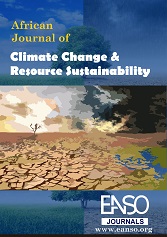The Role of Nature-Based Solutions in Building Resilience to Climate Change: An Analysis Based on the IPCC Vulnerability Framework in Kenya
الملخص
Adaptation to climate change is imperative given that it continues to pose severe and escalating risks to humanity and the ecological systems on which it depends. This calls for Nature-based solutions in climate adaptation since they involve the sustainable management and restoration of ecosystems while improving human livelihoods. However, despite their importance, the potential of Nature-based solutions in building resilience to climate change has not been rigorously studied. Also, no studies have done a joint analysis of the effect of Nature-based solutions on the three dimensions of vulnerability to climate change (exposure, sensitivity, and adaptive capacity. This study thus aimed to undertake a joint analysis of the role of nature-based solutions in building resilience to climate change based on its influence on the three dimensions of vulnerability. Data analysis was done using the multivariate analysis of variance (MANOVA). The study’s multivariate and univariate tests found that nature-based climate solutions influenced the three dimensions of climate change vulnerability (Exposure, sensitivity, and adaptive capacity). The three dimensions of vulnerability were also found to be interconnected and have various relationships between them. The study will help understand how nature-based solutions build resilience to climate change and inform their design and implementation
التنزيلات
المراجع
Anjum, B., Sultana, R., Saddaf, N. 2024. The effectiveness of nature-based solutions to address climate change in Dhaka, Bangladesh. Social Sciences and Humanities Open, 10(2024), 100985. https://doi.org/10.1016/j.ssaho.2024.100985
Boyle, A., and Kuhl, L. 2021. Nature-based Solutions are Job and Livelihood Solutions. UNDP. http://dx.doi.org/10.13140/RG.2.2.20700.92808
Cochran, W., 1963. Sampling Techniques, 2nd Ed. New York: John Wiley and Sons, Inc. https://onlinelibrary.wiley.com/doi/10.1002/zamm.19630431039
Dunlop, T., Khojastesh, D., Cohen-Shacham, E., Glamore, W., Haghani, M.,Van den Bosch, M., Rizzi, D., Greve, P., Felder, S. 2024. The evolution and future of research on Nature-based Solutions to address societal challenges. Communications Earth and Environment, 2024(5): 132. https://doi.org/10.1038/s43247-024-01308-8
European Commission. 2021. Evaluating the impact of Nature-based Solutions: a summary for policymakers, Publications Office. https://doi.org/10.2777/521937
European Union. 2020. Nature-Based Solutions: State of the Art in EU-funded Projects. European Union. https://research-and-innovation.ec.europa.eu/knowledge-publications-tools-and-data/publications/all-publications/nature-based-solutions-state-art-eu-funded-projects_en
FAO. 2009. FAO and Traditional Knowledge: The Linkages with Sustainability, Food Security, and Climate Change Impacts. http://www.fao.org/3/i0841e/i0841e00.htm
Gonzales-Zuñiga, S., Frauke, R., Rawlins, J., Luijten, J., Granadillos, J. 2018. SCAN (SDG & Climate Action Nexus) tool: linking climate action and the sustainable development goals. Key Findings Note. http://ambitiontoaction.net/wp- content/uploads/2018/10/Key_findings_final.pdf.
Government of Kenya, 2019. Kenya population and housing census Vol II; Distribution of population by administrative units, Government of Kenya. https://www.knbs.or.ke/2019-kenya-population-and-housing-census-reports/
Government of Kenya, 2023. Kakamega County Integrated Development Plan. Government of Kenya. https://kakamega-assembly.go.ke/assets/file/fac5e60d-cidp.pdf
Hamilton, S.E., Friess, D.A. 2018. Global carbon stocks and potential emissions due to mangrove deforestation from 2000 to 2012, Nature Climate Change 8 (3), 240–244, https://doi.org/10.1038/s41558-018-0090-4.
Hawken. 2017. Tree Intercropping. Drawdown. https://www.drawdown.org/solutions/tree-intercropping
Inter-American Development Bank. 2020. Increasing infrastructure resilience with NbS, a 12-step technical guidance document for project developers, Inter-American Development Bank. https://publications.iadb.org/en/increasing-infrastructure-resilience-with-nature-based-solutions-nbs
IPCC, Climate change 2022: impacts, adaptation, and vulnerability. Contribution of Working Group II to the Sixth Assessment Report of the Intergovernmental Panel on Climate Change, Cambridge University Press, 2022. https://www.ipcc.ch/report/ar6/wg2/
IUCN. (2016). Nature-based solutions to address global societal challenges. https://portals.iucn.org/library/sites/library/files/documents/2016-036.pdf
IUCN. 2020. Global Standard for Nature-based Solutions. A user-friendly framework for the verification, design, and scaling up of NbS. 978-2-8317-2058-6. IUCN, Gland, Switzerland. https://doi.org/10.2305/IUCN.CH.2020.08.en.
Johnson, B.A., Estoque, R.C., Li, X., Kumar, P., Dasgupta, R., Avtar, R., Magcale-Macandog, D.B. 2021. High-resolution urban change modeling and flood exposure estimation at a national scale using open geospatial data: a case study of the Philippines, Computers Environment and Urban Systems, 90, 101704, https://doi.org/10.1016/j.
Marshall NA, Marshall PA, Tamelander J, Obura D, Malleret-King D, Cinner JE. 2010. A framework for social adaptation to climate change sustaining tropical coastal communities and industries. Gland, Switzerland: IUCN. https://iucn.org/resources/publication/framework-social-adaptation-climate-change-sustaining-tropical-coastal
Masson-Delmotte V, Zhai P, Pirani A, Connors SL, Péan C, et al., eds. 2021. Climate Change 2021: The Physical Science Basis. Contribution of Working Group I to the Sixth Assessment Report of the Intergovernmental Panel on Climate Change. Cambridge, UK: Cambridge Univ. Press. https://www.ipcc.ch/report/ar6/wg1/downloads/report/IPCC_AR6_WGI_SummaryVolume.pdf
Munang, R., Thiaw, I., Alverson, K., Mumba, M., Liu, J., Rivington, M. 2013. Climate change and ecosystem-based adaptation: a new pragmatic approach to buffering climate change impacts. Current Opinion in Environmental Sustainability, 5 (1), 67–71, https://doi.org/10.1016/j.cosust.2012.12.001.
Nair. 2016. Raised Beds for Vegetable Production. Small Farm Sustainability. https://www.extension.iastate.edu/smallfarms/raised-beds-vegetable-production
Secretariat of the Convention on Biological Diversity. 2009. Connecting biodiversity and climate change mitigation and adaptation: report of the Second Ad Hoc Technical Expert Group on Biodiversity and Climate Change. https://www.cbd.int/doc/publications/cbd-ts-41-en.pdf
Seddon, N., Chausson, A., Berry, P., Girardin, C. A., Smith, A., & Turner, B. (2020). Understanding the value and limits of nature-based solutions to climate change and other global challenges. Philosophical Transactions of the Royal Society B: Biological Sciences, 375(1794), Article 20190120. https://doi.org/10.1098/rstb.2019.0120
Thiault L, Marshall P, Gelcich S, Collin A, Chlous F, Claudet J. 2017. Mapping social-ecological vulnerability to inform local decision-making. Conservation Biology, 32, 447–456. https://doi:10.1111/cobi.12989
United Nations. 2022. The Sustainable Development Goals Report 2022. https://unstats.un.org/sdgs/report/2022/The-Sustainable-Development-Goals-Report-2022.pdf (United Nations, 2022). https://unstats.un.org/sdgs/report/2022/The-Sustainable-Development-Goals-Report-2022.pdf
Vassileva, B. 2023. Nature-Based Solutions for Mitigation and Adaptation towards Climate Change. WWF. https://wwfint.awsassets.panda.org/downloads/wwf_nature_based_solutions_for_climate_change___july_2020_final.pdf
الحقوق الفكرية (c) 2025 Caxton Gitonga Kaua

هذا العمل مرخص حسب الرخصة Creative Commons Attribution 4.0 International License.




























